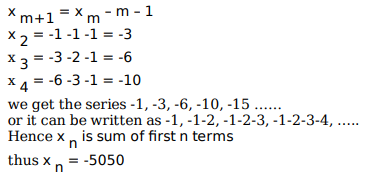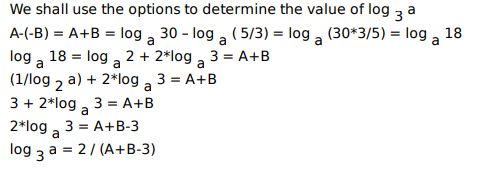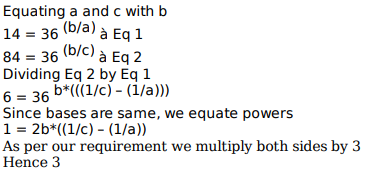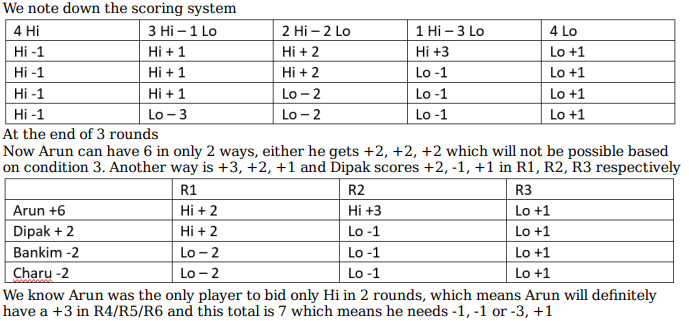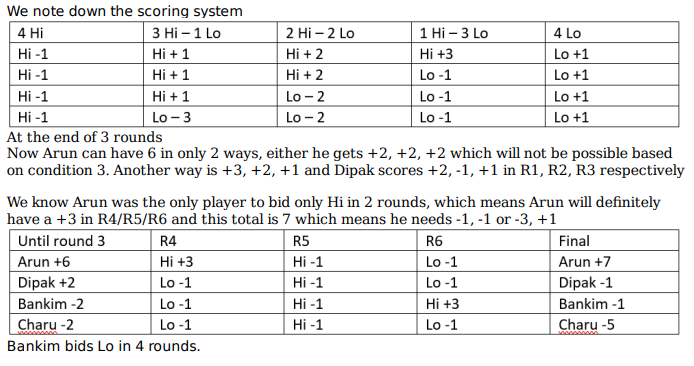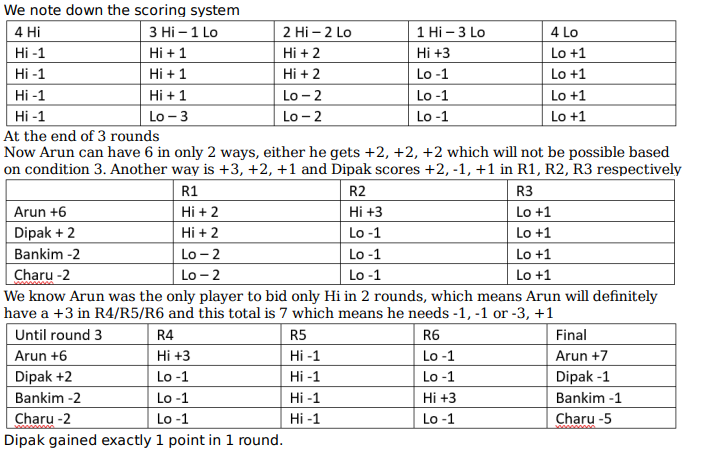Live Updates
• CATKing has launched new chat bot.

• New video on Logs has been released.
495
Learners
asked the doubt

Previous Year Questions
The passage below is accompanied by a set of questions. Choose the best answer to each question.
Mode of transportation affects the travel experience and thus can produce new types of travel writing and perhaps even new “identities.” Modes of transportation determine the types and duration of social encounters; affect the organization and passage of space and time; . . . and also affect perception and knowledge—how and what the traveler comes to know and write about. The completion of the first U.S. transcontinental highway during the 1920s . . . for example, inaugurated a new genre of travel literature about the United States—the automotive or road narrative. Such narratives highlight the experiences of mostly male protagonists “discovering themselves” on their journeys, emphasizing the independence of road travel and the value of rural folk traditions.
Travel writing’s relationship to empire building— as a type of “colonialist discourse”—has drawn the most attention from academicians. Close connections have been observed between European (and American) political, economic, and administrative goals for the colonies and their manifestations in the cultural practice of writing travel books. Travel writers’ descriptions of foreign places have been analyzed as attempts to validate, promote, or challenge the ideologies and practices of colonial or imperial domination and expansion. Mary Louise Pratt’s study of the genres and conventions of 18th- and 19th-century exploration narratives about South America and Africa (e.g., the “monarch of all I survey” trope) offered ways of thinking about travel writing as embedded within relations of power between metropole and periphery, as did Edward Said’s theories of representation and cultural imperialism. Particularly Said’s book, Orientalism, helped scholars understand ways in which representations of people in travel texts were intimately bound up with notions of self, in this case, that the Occident defined itself through essentialist, ethnocentric, and racist representations of the Orient. Said’s work became a model for demonstrating cultural forms of imperialism in travel texts, showing how the political, economic, or administrative fact of dominance relies on legitimating discourses such as those articulated through travel writing. . . .
Feminist geographers’ studies of travel writing challenge the masculinist history of geography by questioning who and what are relevant subjects of geographic study and, indeed, what counts as geographic knowledge itself. Such questions are worked through ideological constructs that posit men as explorers and women as travelers—or, conversely, men as travelers and women as tied to the home. Studies of Victorian women who were professional travel writers, tourists, wives of colonial administrators, and other (mostly) elite women who wrote narratives about their experiences abroad during the 19th century have been particularly revealing. From a “liberal” feminist perspective, travel presented one means toward female liberation for middle- and upper-class Victorian women. Many studies from the 1970s onward demonstrated the ways in which women’s gendered identities were negotiated differently “at home” than they were “away,” thereby showing women’s self-development through travel. The more recent poststructural turn in studies of Victorian travel writing has focused attention on women’s diverse and fragmented identities as they narrated their travel experiences, emphasizing women’s sense of themselves as women in new locations, but only as they worked through their ties to nation, class, whiteness, and colonial and imperial power structures.
From the passage, we can infer that feminist scholars’ understanding of the experiences of Victorian women travellers is influenced by all of the following EXCEPT scholars':
Video Explanation

Explanatory Answer
According to the passage, feminist scholars’ study of the experiences of Victorian women travellers "challenge the masculinist history of geography", by working through "ideological constructs" and has focused attention on "women’s diverse and fragmented identities as they narrated their travel experiences". So, the scholars' fresh perspective, awareness of gender issues and of women's diverse and fragmented identities are discussed in the passage. Only option C is incorrect.
From the passage, we can infer that travel writing is most similar to:
Video Explanation

Explanatory Answer
The passage talks about travel narratives highlighting the experiences of male protagonists "discovering themselves" on their journeys and of Said’s book, Orientalism, helping scholars to "understand ways in which representations of people in travel texts were intimately bound up with notions of self..." So, travel writing, according to the passage, is similar to autobiographical writing.
From the passage, it can be inferred that scholars argue that Victorian women experienced self-development through their travels because:
Video Explanation

Explanatory Answer
According to the last paragraph, "Many studies from the 1970s onward demonstrated the ways in which women’s gendered identities were negotiated differently “at home” than they were “away,” thereby showing women’s self-development through travel."So, option A is correct.
American travel literature of the 1920s:
Video Explanation

Explanatory Answer
According to the first paragraph, American travel narratives in the 1920s "highlight the experiences of mostly male protagonists “discovering themselves” on their journeys, emphasizing the independence of road travel and the value of rural folk traditions". In other words, these narratives celebrated the freedom that travel gives.
According to the passage, Said’s book, “Orientalism”:
Video Explanation

Explanatory Answer
Refer to the last line of the second paragraph: "Said’s work became a model for demonstrating cultural forms of imperialism in travel texts, showing how the political, economic, or administrative fact of dominance relies on legitimating discourses such as those articulated through travel writing."
In other words, Said’s work showed how cultural imperialism was used to justify colonial domination.
The passage below is accompanied by a set of questions. Choose the best answer to each question.
Although one of the most contested concepts in political philosophy, human nature is something on which most people seem to agree. By and large, according to Rutger Bregman in his new book Humankind, we have a rather pessimistic view – not of ourselves exactly, but of everyone else. We see other people as selfish, untrustworthy and dangerous and therefore we behave towards them with defensiveness and suspicion. This was how the 17th-century philosopher Thomas Hobbes conceived our natural state to be, believing that all that stood between us and violent anarchy was a strong state and firm leadership.
But in following Hobbes, argues Bregman, we ensure that the negative view we have of human nature is reflected back at us. He instead puts his faith in Jean-Jacques Rousseau, the 18th-century French thinker, who famously declared that man was born free and it was civilisation – with its coercive powers, social classes and restrictive laws – that put him in chains.
Hobbes and Rousseau are seen as the two poles of the human nature argument and it’s no surprise that Bregman strongly sides with the Frenchman. He takes Rousseau’s intuition and paints a picture of a prelapsarian idyll in which, for the better part of 300,000 years, Homo sapiens lived a fulfilling life in harmony with nature . . . Then we discovered agriculture and for the next 10,000 years it was all property, war, greed and injustice. . . .
It was abandoning our nomadic lifestyle and then domesticating animals, says Bregman, that brought about infectious diseases such as measles, smallpox, tuberculosis, syphilis, malaria, cholera and plague. This may be true, but what Bregman never really seems to get to grips with is that pathogens were not the only things that grew with agriculture – so did the number of humans. It’s one thing to maintain friendly relations and a property-less mode of living when you’re 30 or 40 hunter-gatherers following the food. But life becomes a great deal more complex and knowledge far more extensive when there are settlements of many thousands.
“Civilisation has become synonymous with peace and progress and wilderness with war and decline,” writes Bregman. “In reality, for most of human existence, it was the other way around.” Whereas traditional history depicts the collapse of civilisations as “dark ages” in which everything gets worse, modern scholars, he claims, see them more as a reprieve, in which the enslaved gain their freedom and culture flourishes. Like much else in this book, the truth is probably somewhere between the two stated positions.
In any case, the fear of civilisational collapse, Bregman believes, is unfounded. It’s the result of what the Dutch biologist Frans de Waal calls “veneer theory” – the idea that just below the surface, our bestial nature is waiting to break out. . . . There’s a great deal of reassuring human decency to be taken from this bold and thought-provoking book and a wealth of evidence in support of the contention that the sense of who we are as a species has been deleteriously distorted. But it seems equally misleading to offer the false choice of Rousseau and Hobbes when, clearly, humanity encompasses both.
The author has differing views from Bregman regarding:
Video Explanation

Explanatory Answer
The passage presents the two poles of the human nature argument posed by Hobbbes and Rousseau and asserts that "truth is probably somewhere between the two stated positions". Bregman believes civilisation is synonymous with war and decline and wilderness with peace and progress; the author disagrees.
According to the passage, the “collapse of civilisations” is viewed by Bregman as:
Video Explanation

Explanatory Answer
According to the passage, Bregman sees the collapse of civilisations "more as a reprieve, in which the enslaved gain their freedom and culture flourishes." In other words, he sees it as a time that enables changes in societies and cultures.
None of the following views is expressed in the passage EXCEPT that:
Video Explanation

Explanatory Answer
The only statement that matches the views in the passage is D. In the first paragraph, the passage states, "By and large... we have a rather pessimistic view – not of ourselves exactly, but of everyone else....This was how the 17th-century philosopher Thomas Hobbes conceived our natural state to be.."
According to the author, the main reason why Bregman contrasts life in pre-agricultural societies with agricultural societies is to:
Video Explanation

Explanatory Answer
According to the author, Bregman "paints a picture of a prelapsarian idyll in which, for the better part of 300,000 years, Homo sapiens lived a fulfilling life in harmony with nature . . . Then we discovered agriculture and for the next 10,000 years it was all property, war, greed and injustice". Thus, Bregman, according to the author, portrays agriculture and progress as the root cause for greed and selfishness.
The passage below is accompanied by a set of questions. Choose the best answer to each question.
[There is] a curious new reality: Human contact is becoming a luxury good. As more screens appear in the lives of the poor, screens are disappearing from the lives of the rich. The richer you are, the more you spend to be off-screen. . . .
The joy — at least at first — of the internet revolution was its democratic nature. Facebook is the same Facebook whether you are rich or poor. Gmail is the same Gmail. And it’s all free. There is something mass market and unappealing about that. And as studies show that time on these advertisement-support platforms is unhealthy, it all starts to seem déclassé, like drinking soda or smoking cigarettes, which wealthy people do less than poor people. The wealthy can afford to opt out of having their data and their attention sold as a product. The poor and middle class don’t have the same kind of resources to make that happen.
Screen exposure starts young. And children who spent more than two hours a day looking at a screen got lower scores on thinking and language tests, according to early results of a landmark study on brain development of more than 11,000 children that the National Institutes of Health is supporting. Most disturbingly, the study is finding that the brains of children who spend a lot of time on screens are different. For some kids, there is premature thinning of their cerebral cortex. In adults, one study found an association between screen time and depression. . . .
Tech companies worked hard to get public schools to buy into programs that required schools to have one laptop per student, arguing that it would better prepare children for their screen-based future. But this idea isn’t how the people who actually build the screen-based future raise their own children. In Silicon Valley, time on screens is increasingly seen as unhealthy. Here, the popular elementary school is the local Waldorf School, which promises a back-to-nature, nearly screen-free education. So as wealthy kids are growing up with less screen time, poor kids are growing up with more. How comfortable someone is with human engagement could become a new class marker.
Human contact is, of course, not exactly like organic food . . . . But with screen time, there has been a concerted effort on the part of Silicon Valley behemoths to confuse the public. The poor and the middle class are told that screens are good and important for them and their children. There are fleets of psychologists and neuroscientists on staff at big tech companies working to hook eyes and minds to the screen as fast as possible and for as long as possible. And so human contact is rare. . . .
There is a small movement to pass a “right to disconnect” bill, which would allow workers to turn their phones off, but for now a worker can be punished for going offline and not being available. There is also the reality that in our culture of increasing isolation, in which so many of the traditional gathering places and social structures have disappeared, screens are filling a crucial void.
Which of the following statements about the negative effects of screen time is the author least likely to endorse?
Video Explanation

Explanatory Answer
The author discusses the negative effects of screen time and mentions the fact that it causes depression in adults, that it has adverse effects on children's learing and that it is designed to be addictive. The author is unlikely to endorse the view that screen time increases human contact, as it fills a void.
The statement “The richer you are, the more you spend to be off-screen” is supported by which other line from the passage?
Video Explanation

Explanatory Answer
The given statement implies that the class you belong to decides how much time you spend off-screen. Screen time, according to the passage is "déclassé". Option C states the same idea.
The author claims that Silicon Valley tech companies have tried to “confuse the public” by:
Video Explanation

Explanatory Answer
In paragraph 4, the author states that people who actually build a screen-based future do not raise their own children that way: "In Silicon Valley, time on screens is increasingly seen as unhealthy.Here, the popular elementary school is the local Waldorf School, which promises a back-to-nature, nearly screen-free education."
The passage below is accompanied by a set of questions. Choose the best answer to each question.
I’ve been following the economic crisis for more than two years now. I began working on the subject as part of the background to a novel, and soon realized that I had stumbled across the most interesting story I’ve ever found. While I was beginning to work on it, the British bank Northern Rock blew up, and it became clear that, as I wrote at the time, “If our laws are not extended to control the new kinds of super-powerful, super-complex, and potentially super-risky investment vehicles, they will one day cause a financial disaster of global-systemic proportions.” . . . I was both right and too late, because all the groundwork for the crisis had already been done—though the sluggishness of the world’s governments, in not preparing for the great unraveling of autumn 2008, was then and still is stupefying. But this is the first reason why I wrote this book: because what’s happened is extraordinarily interesting. It is an absolutely amazing story, full of human interest and drama, one whose byways of mathematics, economics, and psychology are both central to the story of the last decades and mysteriously unknown to the general public. We have heard a lot about “the two cultures” of science and the arts—we heard a particularly large amount about it in 2009, because it was the fiftieth anniversary of the speech during which C. P. Snow first used the phrase. But I’m not sure the idea of a huge gap between science and the arts is as true as it was half a century ago—it’s certainly true, for instance, that a general reader who wants to pick up an education in the fundamentals of science will find it easier than ever before. It seems to me that there is a much bigger gap between the world of finance and that of the general public and that there is a need to narrow that gap, if the financial industry is not to be a kind of priesthood, administering to its own mysteries and feared and resented by the rest of us. Many bright, literate people have no idea about all sorts of economic basics, of a type that financial insiders take as elementary facts of how the world works. I am an outsider to finance and economics, and my hope is that I can talk across that gulf.
My need to understand is the same as yours, whoever you are. That’s one of the strangest ironies of this story: after decades in which the ideology of the Western world was personally and economically individualistic, we’ve suddenly been hit by a crisis which shows in the starkest terms that whether we like it or not—and there are large parts of it that you would have to be crazy to like—we’re all in this together. The aftermath of the crisis is going to dominate the economics and politics of our societies for at least a decade to come and perhaps longer.
Which one of the following, if false, could be seen as supporting the author’s claims?
Video Explanation

Explanatory Answer
Trickily worded question. The option that, if false, supports the author's claims is the one that, if true, does not support the author's claims.
From the first line of the passage, we know that the author has been following the economic crisis for more than two years. The author clearly states that he is "not sure the idea of a huge gap between science and the arts is as true as it was half a century ago". Also, according to the author, "many bright, literate people have no idea about all sorts of economic basics". So, options A, B and D, if true, support the author's claims.
On the other hand, the author states that the crisis was due to "the sluggishness of the world’s governments" not preparing for the great unraveling of autumn 2008 . The statement that the economic crisis was not a failure of collective action to rectify economic problems goes against the author's view. So, option C, if true, does not support the author's claims.
Which one of the following, if true, would be an accurate inference from the first sentence of the passage?
Video Explanation

Explanatory Answer
From the first line of the passage, we understand that the author has been following the economic crisis for more than two years, i.e not less than two years.
Which one of the following best captures the main argument of the last paragraph of the passage?
Video Explanation

Explanatory Answer
The main idea of the last paragraph is stated in the line, "after decades in which the ideology of the Western world was personally and economically individualistic, we’ve suddenly been hit by a crisis which shows in the starkest terms that whether we like it or not—and there are large parts of it that you would have to be crazy to like—we’re all in this together". Option C captures this idea well.
All of the following, if true, could be seen as supporting the arguments in the passage, EXCEPT:
Video Explanation

Explanatory Answer
The author calls the crisis "absolutely amazing story, full of human interest and drama, one whose byways of mathematics, economics, and psychology are both central to the story". So, Option A is in line with the arguments in the passage.
While beginning to work on the crisis the author wrote that was extending the laws to control risky investment vehicles was essential to avoid a global financial disaster. Option B, too, is in line with the arguments in the passage.
The author also states that "there is a need to narrow that gap, if the financial industry is not to be a kind of priesthood, administering to its own mysteries and feared and resented by the rest of us". In other words, financial matters have become very arcane and difficult to understand. So, option D supports the arguments in the passage.
However, in the last paragraph, the author states that the economic crisis shows the failure of the personally and economically individualistic ideology of the Western world. So, option C, if true, does not support the arguments in the passage.
According to the passage, the author is likely to be supportive of which one of the following programmes?
Video Explanation

Explanatory Answer
The author laments the fact that many bright, literate people have no idea about all sorts of economic basics. So, he is likely to be supportive of an educational curriculum that promotes developing financial literacy in the masses.
Note that option A is incorrect as it talks of economic "research". There is no basis for options C and D in the passage.
The passage given below is followed by four alternate summaries. Choose the option that best captures the essence of the passage.
Brown et al. (2001) suggest that ‘metabolic theory may provide a conceptual foundation for much of ecology just as genetic theory provides a foundation for much of evolutionary biology’. One of the successes of genetic theory is the diversity of theoretical approaches and models that have been developed and applied. A Web of Science (v. 5.9. Thomson Reuters) search on genetic* + theor* + evol* identifies more than 12000 publications between 2005 and 2012. Considering only the 10 most-cited papers within this 12000 publication set, genetic theory can be seen to focus on genome dynamics, phylogenetic inference, game theory and the regulation of gene expression. There is no one fundamental genetic equation, but rather a wide array of genetic models, ranging from simple to complex, with differing inputs and outputs, and divergent areas of application, loosely connected to each other through the shared conceptual foundation of heritable variation.
Video Explanation

Explanatory Answer
The paragraph starts with the idea that metabolic theory may provide a conceptual foundation for ecology just as genetic theory did for evolutionary biology. It goes on to explain how the genetic theory worked: through wide array of genetic models loosely connected to each other through theshared conceptual foundation. Option B captures both ideas.
Option A states that metabolic theory "must have" the same range of theoretical approaches and applications. This is not what the paragraph says. Option C does not mention metabolic theory while option D is incorrect, based on the information in the paragraph.
The four sentences (labelled A, B, C, D) below, when properly sequenced would yield a coherent paragraph. Decide on the proper sequencing of the order of the sentences and key in the sequence of the four numbers as your answer:
A. It advocated a conservative approach to antitrust enforcement that espouses faith in efficient markets and voiced suspicion regarding the merits of judicial intervention to correct anticompetitive practices.
B. Many industries have consistently gained market share, the lion’s share - without any official concern; the most successful technology companies have grown into veritable titans, on the premise that they advance ‘public interest’.
C. That the new anticompetitive risks posed by tech giants like Google, Facebook, and Amazon, necessitate new legal solutions could be attributed to the dearth of enforcement actions against monopolies and the few cases challenging mergers in the USA.
D. The criterion of ‘consumer welfare standard’ and the principle that antitrust law should serve consumer interests and that it should protect competition rather than individual competitors was an antitrust law introduced by, and named after, the 'Chicago school'.
Video Explanation

Explanatory Answer
Sentence D is the best opening sentence as it sets the context, discussing the principle behind antitrust law. DA is a sequence: the pronoun 'it' that A starts with clearly applies to the Chicago school mentioned in D. BC is also a link:B talks about the consistent growth of tech titans and C attributes this to the dearth of enforcement actions. So, DABC is the correct order.
The passage given below is followed by four alternate summaries. Choose the option that best captures the essence of the passage.
Aesthetic political representation urges us to realize that ‘the representative has autonomy with regard to the people represented’ but autonomy then is not an excuse to abandon one’s responsibility. Aesthetic autonomy requires cultivation of ‘disinterestedness’ on the part of actors which is not indifference. To have disinterestedness, that is, to have comportment towards the beautiful that is devoid of all ulterior references to use – requires a kind of aesthetic commitment; it is the liberation of ourselves for the release of what has proper worth only in itself.
Video Explanation

Explanatory Answer
The main idea of the paragraph is that aesthetic political representation requires that the actor has autonomy with regard to the portrayal and that this involves the cultivation of disinterestedness (which is different from indifference) on part of the actors. Option B captures the essence of the paragraph.
Option A talks of a "non-subjective evaluation of things", something that is not mentioned in the paragraph. Option C does not include the key word 'aesthetic'. Option D states that autonomy is "manifested through" (shown clearly by) disinterestedness. The paragraph only urges the cultivation of disinterestedness in order to liberate oneself from all ulterior references.
The four sentences (labelled A, B, C, D) below, when properly sequenced would yield a coherent paragraph. Decide on the proper sequencing of the order of the sentences and key in the sequence of the four numbers as your answer:
A. Each one personified a different aspect of good fortune.
B. The others were versions of popular Buddhist gods, Hindu gods and Daoist gods.
C. Seven popular Japanese deities, the Shichi Fukujin, were considered to bring good luck and happiness.
D. Although they were included in the Shinto pantheon, only two of them, Daikoku and Ebisu, were indigenous Japanese gods
Video Explanation

Explanatory Answer
C is the best opening sentence. C talks of seven popular Japanese deities. Sentence A adds to C, stating that each one personified a different aspect of good fortune. DB is a clear link, D talks of two of the deities, and B the others. CADB is hence the right order.
Five jumbled up sentences, related to a topic, are given below. Four of them can be put together to form a coherent paragraph. Identify the odd one out and key in the number of the sentence as your answer:
A. The logic of displaying one’s inner qualities through outward appearance was based on a distinction between being a woman and being feminine.
B. 'Appearance' became a signifier of conduct - to look was to be and conformity to the feminine ideal was measured by how well women could use the tools of the fashion and beauty industries.
C. The makeover-centric media sets out subtly and not-so-subtly, ‘good’ and ‘bad’ ways to be a woman, layering these over inequalities of race and class.
D. The denigration of working-class women and women of colour often centres on their perceived failure to embody feminine beauty.
E. ‘Woman’ was considered a biological category, but femininity was a ‘process’ by which women became specific kinds of women.
Video Explanation

Explanatory Answer
The sentences relate to subject of being a woman versus being feminine. EB is a link. The sentences are structured similarly and state what signifies what. Sentence A relates to the same idea. AEB is a possible sequence. Between C and D, D fits better to the idea in B--the measure of the feminine ideal.
C, which is about how the 'make-over centric media' set out to define 'good' and 'bad' ways to be a woman, is the odd one out.
The four sentences (labelled A, B, C, D) below, when properly sequenced would yield a coherent paragraph. Decide on the proper sequencing of the order of the sentences and key in the sequence of the four numbers as your answer:
A. Complex computational elements of the CNS are organized according to a “nested” hierarchic criterion; the organization is not permanent and can change dynamically from moment to moment as they carry out a computational task.
B. Echolocation in bats exemplifies adaptation produced by natural selection; a function not produced by natural selection for its current use is exaptation -- feathers might have originally arisen in the context of selection for insulation.
C. From a structural standpoint, consistent with exaptation, the living organism is organized as a complex of “Russian Matryoshka Dolls” -- smaller structures are contained within larger ones in multiple layers.
D. The exaptation concept, and the Russian-doll organization concept of living beings deduced from studies on evolution of the various apparatuses in mammals, can be applied for the most complex human organ: the central nervous system (CNS).
Video Explanation

Explanatory Answer
DA is a link. D talks of various concepts being applied to the central nervous system. Sentence A is about the central nervous system. D, however, is not the opening sentence of the paragraph, as it talks of the 'exaptation' concept and 'Russian doll organisation' concept, the meaning of which is not clear from D. B explains what exaptation is and C what Russsian doll organisation is. So, BCDA is the right order.
The official answer puts C after D which is incorrect, as the Russian Doll concept is introduced in C.
Five jumbled up sentences, related to a topic, are given below. Four of them can be put together to form a coherent paragraph. Identify the odd one out and key in the number of the sentence as your answer:
A. Machine learning models are prone to learning human-like biases from the training data that feeds these algorithms.
B. Hate speech detection is part of the on-going effort against oppressive and abusive language on social media.
C. The current automatic detection models miss out on something vital: context.
D. It uses complex algorithms to flag racist or violent speech faster and better than human beings alone.
E. For instance, algorithms struggle to determine if group identifiers like "gay" or "black" are used in offensive or prejudiced ways because they're trained on imbalanced datasets with unusually high rates of hate speech.
Video Explanation

Explanatory Answer
If the sentences were to be arranged in a paragraph, B would be the best opening sentence as it sets the context. BD is a link: B talks about hate speech detection while D explains how it works. AE is also a link: sentence A talks about biases arising due to training data. E gives an example of how flawed training data affects algorithms. BDAE is a possible sequence. C is the odd one out.
The passage below is accompanied by a set of questions. Choose the best answer to each question.
Nature has all along yielded her flesh to humans. First, we took nature's materials as food, fibers, and shelter. Then we learned to extract raw materials from her biosphere to create our own new synthetic materials. Now Bios is yielding us her mind-we are taking her logic.
Clockwork logic-the logic of the machines-will only build simple contraptions. Truly complex systems such as a cell, a meadow, an economy, or a brain (natural or artificial) require a rigorous nontechnological logic. We now see that no logic except bio-logic can assemble a thinking device, or even a workable system of any magnitude.
It is an astounding discovery that one can extract the logic of Bios out of biology and have something useful. Although many philosophers in the past have suspected one could abstract the laws of life and apply them elsewhere, it wasn't until the complexity of computers and human-made systems became as complicated as living things, that it was possible to prove this. It's eerie how much of life can be transferred. So far, some of the traits of the living that have successfully been transported to mechanical systems are: self-replication, self-governance, limited self-repair, mild evolution, and partial learning.
We have reason to believe yet more can be synthesized and made into something new. Yet at the same time that the logic of Bios is being imported into machines, the logic of Technos is being imported into life. The root of bioengineering is the desire to control the organic long enough to improve it. Domesticated plants and animals are examples of technos-logic applied to life. The wild aromatic root of the Queen Anne's lace weed has been fine-tuned over generations by selective herb gatherers until it has evolved into a sweet carrot of the garden; the udders of wild bovines have been selectively enlarged in a "unnatural" way to satisfy humans rather than calves. Milk cows and carrots, therefore, are human inventions as much as steam engines and gunpowder are. But milk cows and carrots are more indicative of the kind of inventions humans will make in the future: products that are grown rather than manufactured.
Genetic engineering is precisely what cattle breeders do when they select better strains of Holsteins, only bioengineers employ more precise and powerful control. While carrot and milk cow breeders had to rely on diffuse organic evolution, modern genetic engineers can use directed artificial evolution-purposeful design-which greatly accelerates improvements.
The overlap of the mechanical and the lifelike increases year by year. Part of this bionic convergence is a matter of words. The meanings of "mechanical" and "life" are both stretching until all complicated things can be perceived as machines, and all self-sustaining machines can be perceived as alive. Yet beyond semantics, two concrete trends are happening: (1) Human-made things are behaving more lifelike, and (2) Life is becoming more engineered. The apparent veil between the organic and the manufactured has crumpled to reveal that the two really are, and have always been, of one being.
The author claims that, "Part of this bionic convergence is a matter of words". Which one of the following statements best expresses the point being made by the author?
Video Explanation

Explanatory Answer
The author says that overlap of the mechanical and the lifelike increases year by year and that part of this bionic convergence is a matter of words. The point the author makes here is that the difference between the mechanical and the lifelike is becoming more and more blurred.
Which one of the following sets of words/phrases best serves as keywords to the passage?
Video Explanation

Explanatory Answer
The convergence of bio-logic and technos-logic is the main idea of the passage. Option D contains all important keywords.
All other options contain words like carrots and Hosteins which are not keywords.
None of the following statements is implied by the arguments of the passage, EXCEPT:
Video Explanation

Explanatory Answer
The question can be rephrased as only one of the given statements is implied by the passage.
Option C can be inferred from the passage based on the lines, "Genetic engineering is precisely what cattle breeders do when they select better strains of Holsteins, only bioengineers employ more precise and powerful control. While carrot and milk cow breeders had to rely on diffuse organic evolution, modern genetic engineers can use directed artificial evolution—purposeful design—which greatly accelerates improvements."
The passage says that directed artificial evolution or purposeful design is used by genetic engineers but it does not state or imply that this is "the pinnacle of scientific expertise". So, option A is out.
The passage clearly states that the logic of the Bios is more complex than the logic of machines. So, option B is incorrect.
According to the passage, many philosophers in the past have "suspected" one could abstract the laws of life and apply them elsewhere. Option D is incorrect as it says philosophers have known this.
The author claims that, "The apparent veil between the organic and the manufactured has crumpled to reveal that the two really are, and have always been, of one being." Which one of the following statements best expresses the point being made by the author here?
Video Explanation

Explanatory Answer
The given statement implies that the lines demarking the organic and the manufactured have blurred and the two are and have always been the same. In other words, scientific advances are making it increasingly difficult to distinguish between organic reality and manufactured reality.
Let N, x and y be positive integers such that N = x + y, 2 < x < 10 and 14 < y < 23. If N > 25, then how many distinct values are possible for N?
Video Explanation

Explanatory Answer
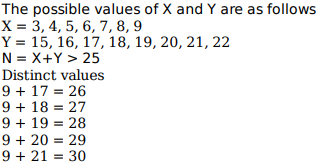

A contractor agreed to construct a 6 km road in 200 days. He employed 140 persons for the work. After 60 days, he realized that only 1.5 km road has been completed. How many additional people would he need to employ in order to finish the work exactly on time?
Video Explanation

Explanatory Answer

The area, in sq. units, enclosed by the lines x = 2, y = |x - 2| + 4, the X-axis and the Y-axis is equal to
Video Explanation

Explanatory Answer
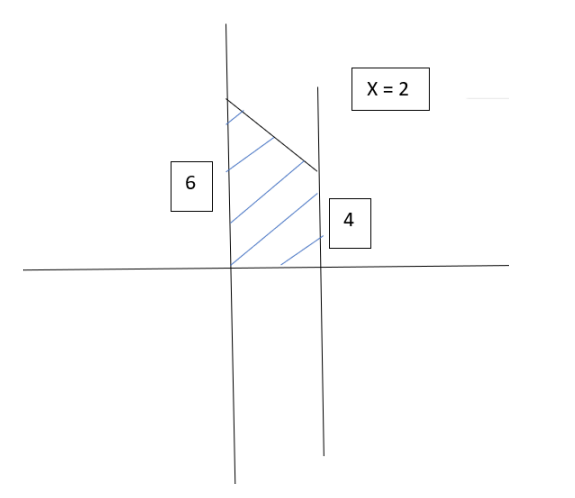

Dick is thrice as old as Tom and Harry is twice as old as Dick. If Dick's age is 1 year less than the average age of all three, then Harry's age, in years, is
Video Explanation

Explanatory Answer

How many of the integers 1, 2, … , 120, are divisible by none of 2, 5 and 7?
Video Explanation

Explanatory Answer

In the final examination, Bishnu scored 52% and Asha scored 64%. The marks obtained by Bishnu is 23 less, and that by Asha is 34 more than the marks obtained by Ramesh. The marks obtained by Geeta, who scored 84%, is
Video Explanation

Explanatory Answer

If f(x+y) = f(x)f(y) and f(5) = 4, then f(10) - f(-10) is equal to
Video Explanation

Explanatory Answer


Anil, Sunil, and Ravi run along a circular path of length 3 km, starting from the same point at the same time, and going in the clockwise direction. If they run at speeds of 15 km/hr, 10 km/hr, and 8 km/hr, respectively, how much distance in km will Ravi have run when Anil and Sunil meet again for the first time at the starting point?
Video Explanation

Explanatory Answer

A man buys 35 kg of sugar and sets a marked price in order to make a 20% profit. He sells 5 kg at this price, and 15 kg at a 10% discount. Accidentally, 3 kg of sugar is wasted. He sells the remaining sugar by raising the marked price by p percent so as to make an overall profit of 15%. Then p is nearest to
Video Explanation

Explanatory Answer

Let k be a constant. The equations kx + y = 3 and 4x + ky = 4 have a unique solution if and only if
Video Explanation

Explanatory Answer

How many integers in the set {100, 101, 102, ., 999} have at least one digit repeated?
Video Explanation

Explanatory Answer

A batsman played n + 2 innings and got out on all occasions. His average score in these n + 2 innings was 29 runs and he scored 38 and 15 runs in the last two innings. The batsman scored less than 38 runs in each of the first n innings. In these n innings, his average score was 30 runs and lowest score was x runs. The smallest possible value of x is
Video Explanation

Explanatory Answer

Two alcohol solutions, A and B, are mixed in the proportion 1:3 by volume. The volume of the mixture is then doubled by adding solution A such that the resulting mixture has 72% alcohol. If solution A has 60% alcohol, then the percentage of alcohol in solution B is
Video Explanation

Explanatory Answer

The vertices of a triangle are (0,0), (4,0) and (3,9). The area of the circle passing through these three points is
Video Explanation

Explanatory Answer
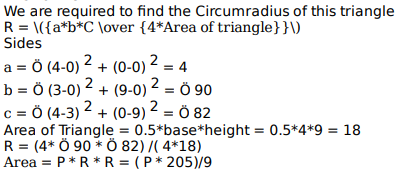
A and B are two railway stations 90 km apart. A train leaves A at 9:00 am, heading towards B at a speed of 40 km/hr. Another train leaves B at 10:30 am, heading towards A at a speed of 20 km/hr. The trains meet each other at
Video Explanation

Explanatory Answer

Vimla starts for office every day at 9 am and reaches exactly on time if she drives at her usual speed of 40 km/hr. She is late by 6 minutes if she drives at 35 km/hr. One day, she covers two-thirds of her distance to office in one-thirds of her usual time to reach office, and then stops for 8 minutes. The speed, in km/hr, at which she should drive the remaining distance to reach office exactly on time is
Video Explanation

Explanatory Answer

In a trepezium ABCD, AB is parallel to DC, BC is perpendicular to DC and ∠BAD = 45°. If DC = 5 cm, BC = 4 cm, the area of the trepezium in sq. cm is
Video Explanation

Explanatory Answer
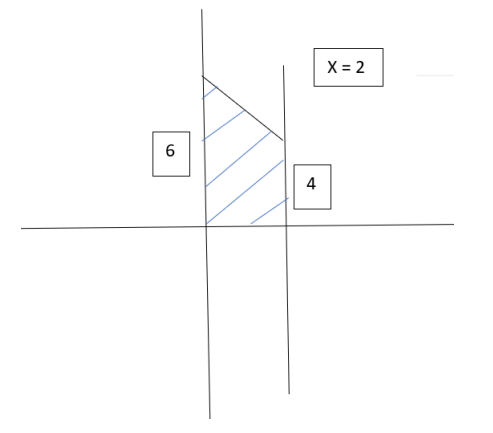

The points (2 , 1) and (-3 , -4) are opposite vertices of a parellelogram. If the other two vertices lie on the line x + 9y + c = 0, then c is
Video Explanation

Explanatory Answer

A farmer had a rectangular land containing 205 trees. He distributed that land among his four daughters – Abha, Bina, Chitra and Dipti by dividing the land into twelve plots along three rows (X,Y,Z) and four Columns (1,2,3,4) as shown in the figure below:
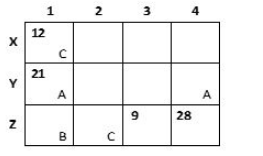
The plots in rows X, Y, Z contained mango, teak and pine trees respectively. Each plot had trees in non-zero multiples of 3 or 4 and none of the plots had the same number of trees. Each daughter got an even number of plots. In the figure, the number mentioned in top left corner of a plot is the number of trees in that plot, while the letter in the bottom right corner is the first letter of the name of the daughter who got that plot (For example, Abha got the plot in row Y and column 1 containing 21 trees). Some information in the figure got erased, but the following is known:
1. Abha got 20 trees more than Chitra but 6 trees less than Dipti.
2. The largest number of trees in a plot was 32, but it was not with Abha.
3. The number of teak trees in Column 3 was double of that in Column 2 but was half of that in Column 4.
4. Both Abha and Bina got a higher number of plots than Dipti.
5. Only Bina, Chitra and Dipti got corner plots.
6. Dipti got two adjoining plots in the same row.
7. Bina was the only one who got a plot in each row and each column.
8. Chitra and Dipti did not get plots which were adjacent to each other (either in row / column / diagonal).
9. The number of mango trees was double the number of teak trees.
How many mango trees were there in total?
Video Explanation

Explanatory Answer
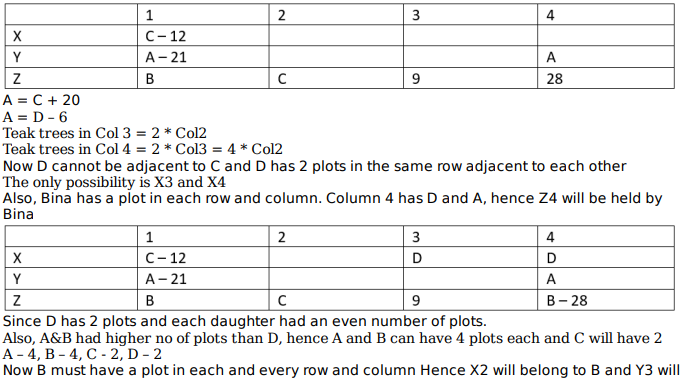
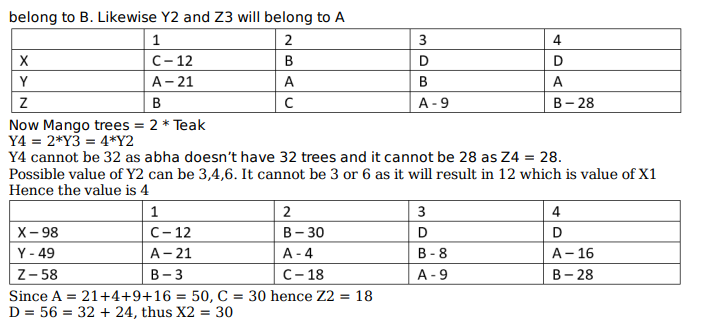
Which of the following is the correct sequence of trees received by Abha, Bina, Chitra and Dipti in that order?
Video Explanation

Explanatory Answer


How many pine trees did Chitra receive?
Video Explanation

Explanatory Answer


Who got the plot with the smallest number of trees and how many trees did that plot have?
Video Explanation

Explanatory Answer


Which of the following statements is NOT true?
Video Explanation

Explanatory Answer


Which column had the highest number of trees?
Video Explanation

Explanatory Answer


The Hi-Lo game is a four-player game played in six rounds. In every round, each player chooses to bid Hi or Lo. The bids are made simultaneously. If all four bid Hi, then all four lose 1 point each. If three players bid Hi and one bids Lo, then the players bidding Hi gain 1 point each and the player bidding Lo loses 3 points. If two players bid Hi and two bid Lo, then the players bidding Hi gain 2 points each and the players bidding Lo lose 2 points each. If one player bids Hi and three bid Lo, then the player bidding Hi gains 3 points and the players bidding Lo lose 1 point each. If all four bid Lo, then all four gain 1 point each.
Four players Arun, Bankim, Charu, and Dipak played the Hi-Lo game. The following facts are known about their game:
1. At the end of three rounds, Arun had scored 6 points, Dipak had scored 2 points, Bankim and Charu had scored -2 points each.
2. At the end of six rounds, Arun had scored 7 points, Bankim and Dipak had scored -1 point each, and Charu had scored -5 points.
3. Dipak’s score in the third round was less than his score in the first round but was more than his score in the second round.
4. In exactly two out of the six rounds, Arun was the only player who bid Hi.
What were the bids by Arun, Bankim, Charu and Dipak, respectively in the first round?
Video Explanation

Explanatory Answer
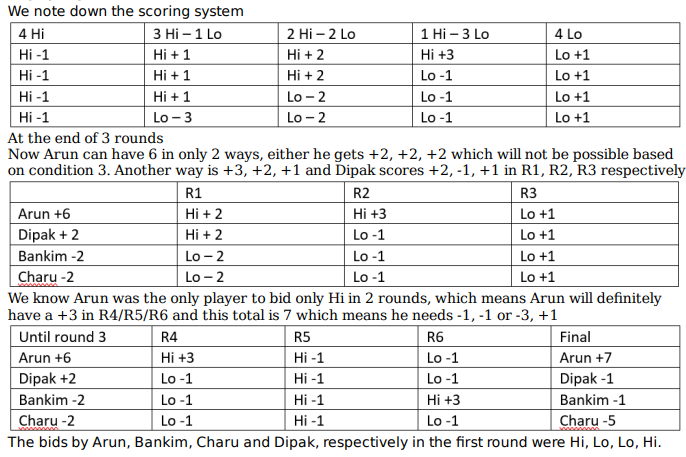
In how many rounds did all four players make identical bids?
Video Explanation

Explanatory Answer
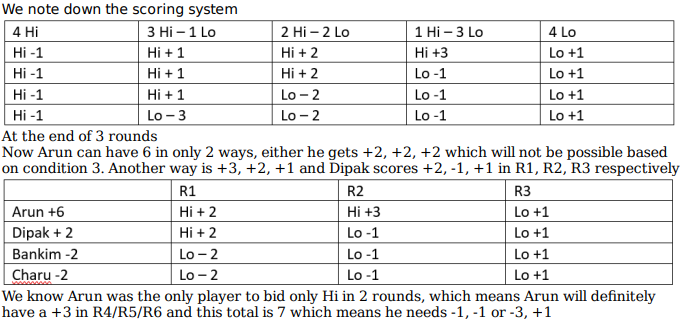

In which of the following rounds, was Arun DEFINITELY the only player to bid Hi?
Video Explanation

Explanatory Answer

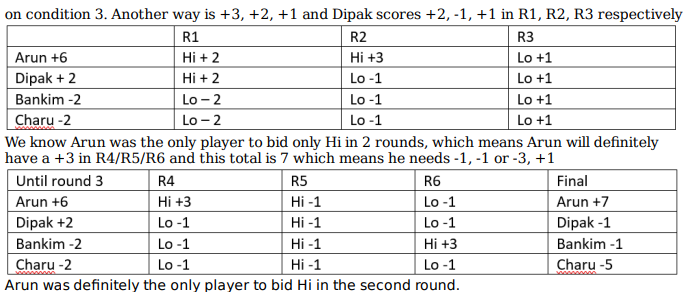
XYZ organization got into the business of delivering groceries to home at the beginning of the last month. They have a two-day delivery promise. However, their deliveries are unreliable. An order booked on a particular day may be delivered the next day or the day after. If the order is not delivered at the end of two days, then the order is declared as lost at the end of the second day. XYZ then does not deliver the order, but informs the customer, marks the order as lost, returns the payment and pays a penalty for non-delivery.
The following table provides details about the operations of XYZ for a week of the last month. The first column gives the date, the second gives the cumulative number of orders that were booked up to and including that day. The third column represents the number of orders delivered on that day. The last column gives the cumulative number of orders that were lost up to and including that day.
It is known that the numbers of orders that were booked on the 11th, 12th, and 13th of the last month that took two days to deliver were 4, 6, and 8 respectively.

Among the following days, the largest fraction of orders booked on which day was lost?
Video Explanation

Explanatory Answer

On which of the following days was the number of orders booked the highest?
Video Explanation

Explanatory Answer

The delivery ratio for a given day is defined as the ratio of the number of orders booked on that day which are delivered on the next day to the number of orders booked on that day which are delivered on the second day after booking. On which of the following days, was the delivery ratio the highest?
Video Explanation

Explanatory Answer

The average time taken to deliver orders booked on a particular day is computed as follows. Let the number of orders delivered the next day be x and the number of orders delivered the day after be y. Then the average time to deliver order is (x+2y)/(x+y). On which of the following days was the average time taken to deliver orders booked the least?
Video Explanation

Explanatory Answer

A survey of 600 schools in India was conducted to gather information about their online teaching learning processes (OTLP).
The following four facilities were studied.
F1: Own software for OTLP
F2: Trained teachers for OTLP
F3: Training materials for OTLP
F4: All students having Laptops
The following observations were summarized from the survey.
1. 80 schools did not have any of the four facilities – F1, F2, F3, F4.
2. 40 schools had all four facilities.
3. The number of schools with only F1, only F2, only F3, and only F4 was 25, 30, 26 and 20 respectively.
4. The number of schools with exactly three of the facilities was the same irrespective of which three were considered.
5. 313 schools had F2.
6. 26 schools had only F2 and F3 (but neither F1 nor F4).
7. Among the schools having F4, 24 had only F3, and 45 had only F2.
8. 162 schools had both F1 and F2.
9. The number of schools having F1 was the same as the number of schools having F4.
What was the number of schools having facilities F2 and F4?
Video Explanation

Explanatory Answer
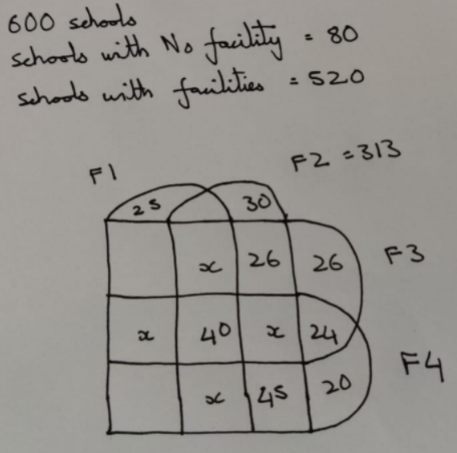
Assume only F1 & F2 = A
We know from condition 8 that F1 and F2 have 162 students
A + x + 40 + x = 162
F2 = 313 = 162 + 26 + 45 + 30 + x
x = 50 and A = 22
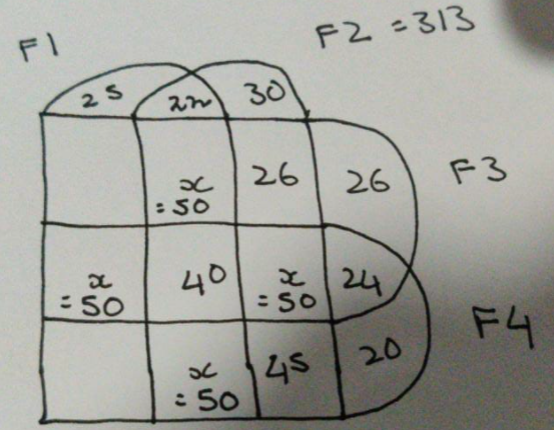
Now F1 & F4 have the same number of schools
We Calculate the values not common to both to balance the figures
F4 = 50 + 45 + 24 + 20 = 139
F1 = 50 + 25 + 22 + x = 139
x = 42
Now to calculate only F1 and F4
520 – 313 – 26 – 24 – 20 – 25 – 42 – 50 = 20
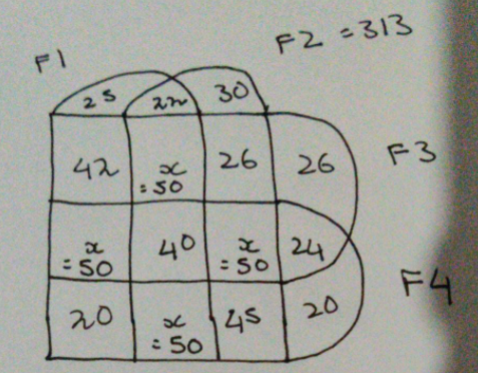
What was the number of schools having only facilities F1 and F3?
Video Explanation

Explanatory Answer

Assume only F1 & F2 = A
We know from condition 8 that F1 and F2 have 162 students
A + x + 40 + x = 162
F2 = 313 = 162 + 26 + 45 + 30 + x
x = 50 and A = 22

Now F1 & F4 have the same number of schools
We Calculate the values not common to both to balance the figures
F4 = 50 + 45 + 24 + 20 = 139
F1 = 50 + 25 + 22 + x = 139
x = 42
Now to calculate only F1 and F4
520 – 313 – 26 – 24 – 20 – 25 – 42 – 50 = 20

What was the number of schools having only facilities F1 and F4?
Video Explanation

Explanatory Answer

Assume only F1 & F2 = A
We know from condition 8 that F1 and F2 have 162 students
A + x + 40 + x = 162
F2 = 313 = 162 + 26 + 45 + 30 + x
x = 50 and A = 22

Now F1 & F4 have the same number of schools
We Calculate the values not common to both to balance the figures
F4 = 50 + 45 + 24 + 20 = 139
F1 = 50 + 25 + 22 + x = 139
x = 42
Now to calculate only F1 and F4
520 – 313 – 26 – 24 – 20 – 25 – 42 – 50 = 20

What was the total number of schools having exactly three of the four facilities?
Video Explanation

Explanatory Answer

Assume only F1 & F2 = A
We know from condition 8 that F1 and F2 have 162 students
A + x + 40 + x = 162
F2 = 313 = 162 + 26 + 45 + 30 + x
x = 50 and A = 22

Now F1 & F4 have the same number of schools
We Calculate the values not common to both to balance the figures
F4 = 50 + 45 + 24 + 20 = 139
F1 = 50 + 25 + 22 + x = 139
x = 42
Now to calculate only F1 and F4
520 – 313 – 26 – 24 – 20 – 25 – 42 – 50 = 20


Suppose vial C tests positive and vials A, E and H test negative. Which patient has the disease?
Video Explanation

Explanatory Answer
IF Vial C tests positive while A, E, H are negative then any patient with vial A, E, H will not have the disease.
Patient 8 and 14 have E hence they are negative. Patient 2 doesn’t have vial C hence it can’t be positive.
Patient 6 has vial C and none of A, E, H.
Suppose vial A tests positive and vials D and G test negative. Which of the following vials should we test next to identify the patient with the disease?
Video Explanation

Explanatory Answer
We see patients 9 to 16 have the vial A, among them patient 9 & 11 have vial D, 10 & 12 have vial D & G hence they cannot be disease positive. Patient 14 & 16 have vial G hence they also can’t test positive. Patient 13 – A, C, F, H and Patient 15 – A, C, E, H
Since A, C, H is common we must test either E or F to confirm the disease.
Which of the following combinations of test results is NOT possible?
Video Explanation

Explanatory Answer
Let’s look at possible positive patients with given conditions option-wise
• Patient 4 can be positive – B, D, E, G
• Patient 14 can be positive – A, C, F, G
• Patient 4 can be positive – B, D, E, H
• This case is not possible
Suppose one of the lab assistants accidentally mixed two patients' blood samples before they were distributed to the vials. Which of the following correctly represents the set of all possible numbers of positive test results out of the eight vials?
Video Explanation

Explanatory Answer
4 vials will definitely give us a positive result.
Patient 1 & 2 – 3 vials common and one unique each makes it 5 vials which can give us a positive result.
Patient 1 & 16 – 8 different vials which can lead to positive results
Our answer must contain 4, 5 and 8 which is only option B.









